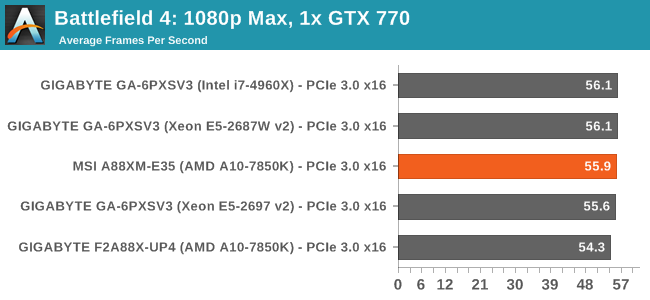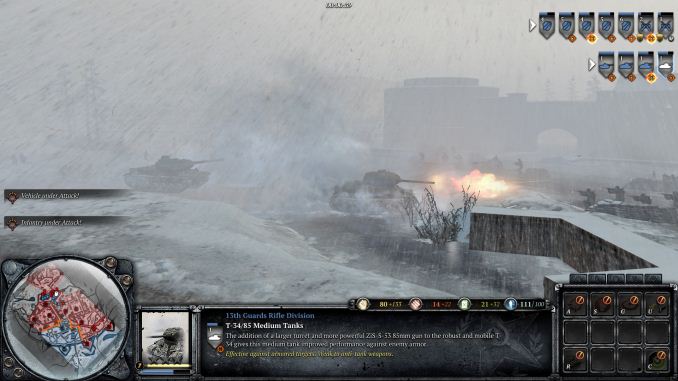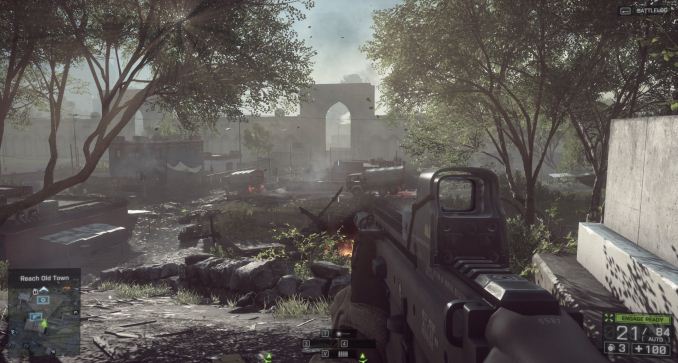MSI A88XM-E35 Motherboard Review: Micro-A88X for $68
by Ian Cutress on April 3, 2014 11:59 AM ESTSleeping Dogs
Sleeping Dogs is a benchmarking wet dream – a highly complex benchmark that can bring the toughest setup and high resolutions down into single figures. Having an extreme SSAO setting can do that, but at the right settings Sleeping Dogs is highly playable and enjoyable. We run the basic benchmark program laid out in the Adrenaline benchmark tool, and the Xtreme (1920x1080, Maximum) performance setting, noting down the average frame rates and the minimum frame rates.

| Sleeping Dogs, 1080p Max | ||
| NVIDIA | AMD | |
| Average Frame Rates | ||
| Minimum Frame Rates | ||
Company of Heroes 2
Company of Heroes 2 also can bring a top end GPU to its knees, even at very basic benchmark settings. To get an average 30 FPS using a normal GPU is a challenge, let alone a minimum frame rate of 30 FPS. For this benchmark I use modified versions of Ryan’s batch files at 1920x1080 on High. COH2 is a little odd in that it does not scale with more GPUs with the drivers we use.

| Company of Heroes 2, 1080p Max | ||
| NVIDIA | AMD | |
| Average Frame Rates | ||
| Minimum Frame Rates | ||
Battlefield 4
The EA/DICE series that has taken countless hours of my life away is back for another iteration, using the Frostbite 3 engine. AMD is also piling its resources into BF4 with the new Mantle API for developers, designed to cut the time required for the CPU to dispatch commands to the graphical sub-system. For our test we use the in-game benchmarking tools and record the frame time for the first ~70 seconds of the Tashgar single player mission, which is an on-rails generation of and rendering of objects and textures. We test at 1920x1080 at Ultra settings.

| Battlefield 4, 1080p Max | ||
| NVIDIA | AMD | |
| Average Frame Rates | ||
| 99th Percentile Frame Rates | ||













27 Comments
View All Comments
khanov - Thursday, April 3, 2014 - link
Also, PS/2 is interrupt-driven, USB requires the CPU to poll the ports. The effect of polling is to use/waste CPU cycles checking if the mouse has moved or a key has been pressed.Interrupt-driven I/O is superior, as it does not waste CPU cycles. The CPU only services the interrupt handler (keyboard/mouse code) when you press a key or move the mouse.
It may be 2014, but PS/2 is a better way to connect both mouse and keyboard than USB. I wish all vendors put both PS/2 ports on all motherboards.
frewster - Friday, April 4, 2014 - link
I seriously doubt any computer from this decade or even the past decade is noticeably slowed down by polling the USB ports.boot318 - Friday, April 4, 2014 - link
I agree. He should just state that he wants the connections, because otherwise, they should be dead.Powerlurker - Friday, April 4, 2014 - link
My assumption is that PS2 ports are still used in industrial computing. They are also a little bit cheaper. Last I checked, HP would cut about $5 or so off the price if you went with a PS2 keyboard over USB. If you're a corporate purchasing agent buying 1000 systems, that's an nontrivial amount of cash with practically no downside.dananski - Friday, April 4, 2014 - link
N-key rollover is why I'd want ps2, but more likely it's that if they're buying a budget board, they might be reusing a really old keyboard.sfuzzz - Tuesday, April 8, 2014 - link
It was an half-joke. No, I think the real reasons are that the PS/2 controller is integrated and fully functional on all chipsets and PS/2 keyboards are guaranteed to always work, especially on BIOS. Call it a failsafe solutionVoldenuit - Thursday, April 3, 2014 - link
Thank you for reviewing a motherboard with a price that's not 3-digits, Ian!LucinaHSacco - Thursday, April 3, 2014 - link
So how about an AMD Kaveri-supporting A88X motherboard priced at just £40? That would surely get some attention, right? The MSI A88XM-E35 is that board and we have it under the spotlight today. http://is.gd/mGuvSUSquattingDog - Thursday, April 3, 2014 - link
Ian, it is "bear that in mind" eg to keep in mind, not "bare that in mind" (naked in mind?! Hate to nitpick but this is at least the second article on this site I've seen it in.Also as other commenters have mentioned what is going on with the overheating of the VRMs? Specific chips or revisions only if all new chips are causing this?
zodiacsoulmate - Thursday, April 3, 2014 - link
The first thing I noticed when taking the motherboard out of the anti-static bag was the lack of a power delivery heatsink.What heatsink is that???????????
Isn't it the little blue thing on the mobo?